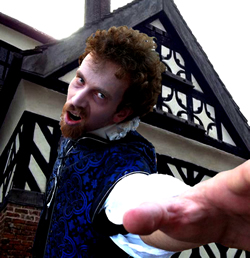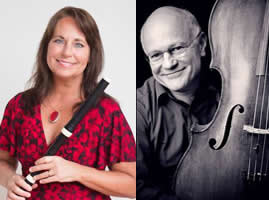Faced with financial uncertainty thanks to the lack of a state budget (yes, it affects our public institutions of higher learning, too), composer and NCSU’s ArtsNow director Rodney Waschka II has shifted around his programs for 2002-3 and thus began the season with a concert devoted entirely to electro-acoustic computer music and videos with nary a live performer (and never mind a guest composer) in sight. Still, the program, presented in the Ballroom of the University Student Center on the evening of September 10, had a lot going for it, including a world premiere. For some in attendance (and the ballroom was nicely filled), it must have been quite an escapist trip – a respite, as it were, from the non-stop 9/11 retrospectives and tributes and such that were elsewhere being brought into our lives, by other electronic means. It’s good to be able to report that technical glitches were few, although one work was a casualty of a little accident; presumably, Jerry Hunt’s intriguingly titled “Birome [zone]: plane (fixture)” will make its ArtsNow debut later in the year.
One reason for the good turn-out, incidentally, may relate to the outstanding article on the concert by Laura England, staff writer for NCSU’s Technician (available online at http://technicianonline.com/read/tol/extra/005671.html [inactive 10/03]). Another, of course, is that there is a “natural” link between high-tech music and the high-tech curriculum offered at good ol’ NCSU.
The program began with John Gibson’s “Thrum,” which despite its origins (it and every other work presented represented “computer” music in one way or another) bore some resemblance to our conventional sound-world; amid the sonic eruptions, there was a section that suggested a wordless chorus and, elsewhere, what sounded distinctly like airplane engines (so perhaps we weren’t quite as removed from thoughts of 9/11 as we’d hoped we would be). The composer is based at Indiana University.
“Heavy Metal,” a music-video by Kristine H. Burns (of Florida International University), began in black & white with stark sounds of metal striking metal that varied in volume and intensity as the video progressed to color. The audience was mostly young, so there were no giggles when PacMan-like shapes appeared on the verge of devouring each other. The work was effective as a mood-piece, but it will take additional viewings to begin to divine its meaning.
Alden Jenks (of San Francisco Conservatory) contributed “Martin Put That Gun Away,” one of the evening’s most fascinating “compositions,” which might almost have been subtitled “Guns [without] Roses.” The work is based on those words, spoken, sampled, and transformed. According to the composer’s program note, the words were perhaps not too well chosen, for their very strength allowed the text to dominate throughout, rather than allowing the work to move from text to sound. Still, it was an intriguing experiment, and in the context of the times, its message was hardly unwelcome.
From composer John Duesenberry (who operates his own, non-affiliated studio) came “Wavebreak,” based on lines by poet John Ashbery and intentionally an evolving tone-poem inspired by the ever-changing sea.
Dennis Miller’s “Second Thoughts,” another music-video, evolves, too, from what looks a bit like test patterns to some truly kaleidoscopic footage. The possibly-recognizable sounds suggested portions of Vaughan Williams’ bleak “Antarctic” Symphony, which some readers will know began life as a film score (for Scott of the Antarctic ). This piece had a certain musical shape, in that it ended pretty much as it began. The composer is at Northeastern University.
One of the composers at last spring’s Computer Music Festival at NCSU was Martin Fumarola, who was represented this time by the intellectually appealing “SC,” named for the SuperCollider software that apparently made it possible. The composer is based at Argentina’s National University of Cordoba.
Another work that merged high tech with music and video was “1921>1989,” for which Barry Schrader (of the California Institute of the Arts) created the “score” to accompany Michael Scroggins’ “film.” It involved a UNIX operating system’s file manipulation convention, which (as one thinks about it) may be ideal for such creations, but curiously it seemed the most conventional of the works presented, often resembling the artificial “music” that we hear all the time in (synthesized) commercials and such, on the tube.
The grand finale was the world premiere of Ian Chuprun’s “I was very safe… in my dream,” which in many ways brought us back to where we’d come in – and (alas) suggested, in many respects, that our sojourn in the mostly darkened ballroom had been but an escape from the reality of life in our post-9/11 world. The piece is a sound-portrait of the innocence of children that involves recorded sound clips of interactions among a family group. There was no music, per se, but the work possesses a certain rhythm and, in the context of the rest of the program, great poignancy. Chuprun is affiliated with Concordia University.
None of the works was longer than eleven minutes, and some of them were quite short. All told, the sum of the diverse parts added up to a thought-provoking and stimulating whole.
One might wonder why Waschka (or anyone else) bothered, since everything was “pre-recorded,” but it’s a fact that despite those ubiquitous home theatre systems, few of us have eight-channel (octophonic) setups, and it’s a fact, too, that hearing (and seeing) these pieces while sitting inside a ring of speakers made a powerful impression. The next ArtsNow concert is planned for October 24, in the same venue. See our calendar after September 24 for details.












